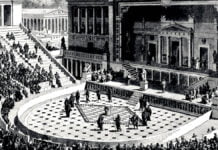Elegy Written in a Country Churchyard is the British writer Thomas Gray’s most famous poem, first published in 1751. It mourns the lives of the obscure and forgotten populace of a rural village, whose resting place is the churchyard, and reflects on the universal themes of mortality, ambition, and the passage of time. The poem is highly regarded for its rich thematic complexity, refined emotional depth, and stylistic excellence.
The poem’s speaker calmly mulls over death while standing in a rural graveyard in the evening. Taking stock of the graves, he reflects that death comes for everyone in the end and notes that the elaborate tombs of the rich won’t bring their occupants back from the dead. He also commemorates the common folk buried in the churchyard by imagining the lives they might have lived had they been born into better circumstances and considers the benefits of anonymity. The poem ends with his own imagined epitaph.
Summary
The poem begins with the speaker describing a rural churchyard at twilight. He reflects on the simple lives and deaths of the villagers buried there, who lived and died in obscurity without achieving fame or fortune. The setting is peaceful and serene, with the fading light casting a melancholy atmosphere over the scene.
The speaker imagines the lives of the villagers buried in the churchyard, picturing them as humble, hardworking individuals who lived quiet, unremarkable lives. He acknowledges that the world may have forgotten their names and deeds, but their virtues and good deeds live on in the memories of those who knew them.
As the poem progresses, the speaker meditates on the universal nature of mortality and the inevitability of death. He reflects on the fleeting nature of life and the inevitability of death for all living beings, regardless of their station in life or worldly accomplishments.
Despite the poem’s sorrowful tone, the speaker’s reflections offer consolation and hope. He suggests that even though the villagers may not have achieved greatness or fame, they are still worthy of respect and remembrance. Their simple lives and quiet virtues remind us of the value of humility, hard work, and kindness.
The poem concludes with the famous epitaph, which reflects on the universal fate of all humanity:
“The paths of glory lead but to the grave”.
Analysis
The central theme of the elegy is the commonality of death. The poet reflects that death is the great equaliser, whether rich or poor. The lives of the simple villagers are depicted as honourable, and their quiet existence is given dignity in death. Gray muses that the villagers’ obscurity may have robbed the world of potentially great but unrecognised talents.
Gray also contemplates his mortality and wonders if anyone will remember him after his death. The poem concludes with a hypothetical meditation on the poet’s own death, imagining a youth in the village recounting the poet’s modest life to a future visitor of the churchyard.
The poem’s melancholic tone emphasises the fleeting nature of life and the universality of mortality. Despite its sombre theme, Elegy Written in a Country Churchyard also recognises the quiet nobility and inherent worth of every human life, no matter how unnoticed.
Universal Themes
One of the most striking aspects of Gray’s elegy is its exploration of universal themes that resonate with readers across time and cultures. The poem meditates on the human condition, the inevitability of death, and the idea that everyone, regardless of their station in life, is equal in death. This universality gives the poem its enduring appeal and makes it relevant to readers of all backgrounds.
Meditation on Mortality
Gray’s elegy is a poignant meditation on the transience of life and the inevitability of death. He reflects on the lives of the simple villagers buried in the churchyard and considers the fleeting nature of human existence. The poet’s meditation on what remains of a person after death—a theme culminating in the image of an epitaph—is a poignant reflection on legacy and remembrance. The final stanzas suggest a personal anxiety about Gray’s legacy, which has garnered discussion about the role of the poet and the longing for immortality through art. Through vivid imagery and evocative language, Gray captures the poignancy of mortality and the sense of loss that accompanies it.
Social Commentary
The poem is often appreciated in the context of the social and intellectual currents of its time. While the poem focuses on the lives of rural villagers, it also contains subtle social commentary on issues such as social inequality, poverty, and the limitations imposed by one’s social class. During the 18th century, England changed due to the Agricultural and Industrial Revolutions that altered the rural landscape and traditional ways of life. Gray’s emphasis on the dignity of common folk can be viewed as a subtle critique of social stratification and the disruption of pastoral life. Gray laments the untapped potential of those buried in the churchyard, suggesting that many may have possessed hidden talents or ambitions that were never realised due to their humble circumstances.
Elegiac Tone
The poem’s elegiac tone imbues it with melancholy and solemnity. Gray’s use of elegiac verse, with its mournful rhythms and solemn diction, creates a sombre and reflective mood that permeates the poem. This tone reinforces the themes of mortality and loss and evokes empathy and introspection in the reader.
Emotive Language and Imagery
The poem is lauded for its emotive language and vivid imagery, creating a solemn and contemplative atmosphere. Gray’s descriptions of the peaceful countryside, the tolling curfew bell, and the fading light of day all contribute to a palpable sense of place and mood that draws the reader into the contemplative experience. Nature serves as a backdrop to the human drama unfolding in the poem and reflects the cyclical nature of life and death. The natural world provides a sense of continuity and solace in the face of mortality.
Elegant Structure and Versification
Written in iambic pentameter and employing a traditional ABAB rhyme scheme, Elegy Written in a Country Churchyard is noted for its elegant structure and lyrical quality. This disciplined approach to versification does not impede the poem’s emotional impact but rather enhances it, showing Gray’s mastery of form.
Elegy Written in a Country Churchyard influenced subsequent generations of poets and became one of the most quoted and anthologised poems in the English language. Its melancholy reflections, embodiment of the “graveyard poets” genre, and moral perspective have all been seen as precursors to the Romanticism movement that would flourish in the latter part of the 18th century and beyond.





























